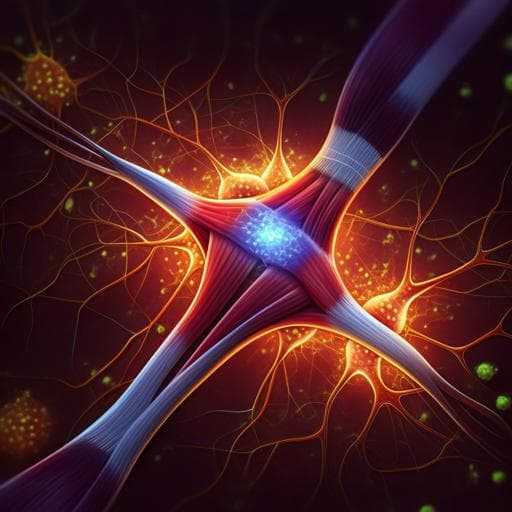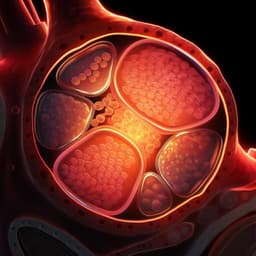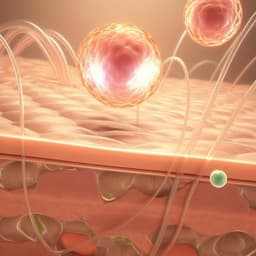
Medicine and Health
Human sensorimotor organoids derived from healthy and amyotrophic lateral sclerosis stem cells form neuromuscular junctions
J. D. Pereira, D. M. Dubreuil, et al.
This groundbreaking research showcases how human induced pluripotent stem cells (iPSC) can be utilized to model various subgroups of amyotrophic lateral sclerosis (ALS), providing insights into the nuances of disease progression through the development of functional sensorimotor organoids with neuromuscular junctions. Conducted by esteemed researchers including João D. Pereira and Brian J. Wainger, this study pushes the boundaries of precision medicine.
~3 min • Beginner • English
Introduction
The neuromuscular junction (NMJ) is a key synapse with diagnostic and therapeutic relevance for motor neuron diseases. In amyotrophic lateral sclerosis (ALS), NMJ degeneration is among the earliest pathological events. Approximately 90% of ALS cases are sporadic and ~10% are familial, involving diverse genes (e.g., SOD1, FUS, TARDBP/TDP-43, PFN1, C9orf72). Given the heterogeneity of genetic backgrounds and human-specific features, iPSC-based disease modeling is needed. However, generating NMJs from human iPSCs has been challenging; many systems rely on primary human or mouse muscle, limiting genotype-specific muscle contributions and have not been robustly validated across multiple lines. This study establishes human sensorimotor organoids that produce functional NMJs and applies them to model distinct ALS variants, hypothesizing that NMJ structure and function will be impaired in ALS backgrounds and that isogenic gene editing will reduce organoid variability and reveal mutation-specific NMJ phenotypes.
Literature Review
Prior work developed protocols for differentiating spinal motor neurons and skeletal muscle from human iPSCs, but co-cultures often required primary human or mouse muscle to form NMJs, reducing the ability to study muscle genotype-specific effects. One report generated NMJs from ALS iPSC-derived motor neurons co-cultured with myoblasts from a single control iPSC line in a microfluidic device, showing impaired entrainment with optogenetic stimulation, but robustness across multiple ALS and control lines remained unclear. Brain and neuromuscular organoid approaches have shown promise, yet concerns persist about among- and within-line variability, which can confound disease modeling. The present study addresses these gaps by creating adherent sensorimotor organoid cultures from multiple iPSC lines, including isogenic pairs carrying familial ALS mutations, and systematically quantifying both structure and function at the NMJ.
Methodology
- iPSC differentiation and organoid generation: Human iPSC lines (two controls; ALS lines with C9orf72 repeat expansion, FUS mutation, and one sporadic ALS; plus CRISPR-edited isogenic pairs harboring TARDBP G298S, SOD1 G85R, PFN1 G118V and matched controls) were aggregated into spheres in suspension and patterned for 7 days toward neuromesodermal progenitors using FGF and WNT pathway agonism plus forskolin. Spheres were then plated at defined density onto Matrigel-coated substrates and maintained up to 15 weeks under adherent conditions to form sensorimotor organoid cultures.
- Cell identity profiling: At 2 weeks, single-cell RNA-seq (inDrop) was performed on triplicate differentiations (27,000 cells total; average 35,000 reads/cell; ~2,555 genes/cell). Seurat clustering (25 clusters) and SPRING analysis identified neural crest, intermediate and neuronal progenitors, neurons, mesenchymal progenitors, myogenic and vascular-related clusters. Immunocytochemistry validated neuronal (TUJ1, ISL1, HB9/MNX1, ChAT), sensory (BRN3A, PRPH), astrocytic (GFAP), microglial (IBA1, TMEM119, CX3CR1 by qPCR), endothelial/microvascular (IB4 staining, CDH5 by qPCR), and skeletal muscle (SAA/α-actinin) markers. Electron microscopy (EM) confirmed vascular lumens and sarcomeric ultrastructure.
- Sensory function assays: Nociceptor-like ganglia were assessed by calcium imaging for capsaicin responsiveness (TrpV1) and by whole-cell patch clamp for TTX-resistant sodium currents (NaV1.8/1.9).
- FACS and subtype quantification: NCAM-based FACS enriched neuronal populations followed by TUJ1, ISL1, BRN3A, and ChAT immunostaining to quantify subtypes.
- NMJ structure and function: NMJs were identified by presynaptic bassoon (BSN) juxtaposed to postsynaptic α-bungarotoxin (α-BTX)-labeled AChRs, and by EM showing synaptic densities. Functional NMJs were evaluated by spontaneous muscle contractions (weeks 8–9), optogenetic stimulation of neurons (hSYN::TsChR2), and pharmacology using curare (postsynaptic antagonist) and botulinum toxin (presynaptic blocker). Contractions were quantified using Fiji optic flow and automated frame subtraction with blinded verification.
- ALS vs control contractility assay: At 7–8 weeks, unbiased selection of muscle-containing fields (six per culture) from control and ALS lines assessed percentage of contractile sites and contraction rates, and specifically analyzed large contractions (>50% field).
- Isogenic line generation and validation: CRISPR/Cas9 editing created heterozygous mutations (TARDBP G298S, SOD1 G85R, PFN1 G118V) in FA0000011 background; paired unedited clones served as controls. Whole-exome sequencing assessed off-targets and clustering; isogenic lines were differentiated and characterized (GFAP+ astrocytes, IBA1+ microglia, SAA+ muscle) for composition and variance analyses.
- Variance analysis: Among-line variance compared non-isogenic (n=5) to isogenic (n=6) lines via F-tests; within-line variance assessed by one-way ANOVA across metrics (sphere potency/area at day 2; astrocytes, microglia, muscle at week 6).
- Neurite outgrowth and NMJ quantification in isogenic lines: AAV9 hSYN::EGFP labeling tracked neurite area longitudinally (weeks 3–9). At week 15, α-BTX clusters and EGFP puncta were quantified across randomized grid sites to compute percentage of innervated NMJs and area of innervated NMJs; analyses normalized to isogenic controls and performed blinded. Statistical tests included ANOVA, t-tests, Mann–Whitney as appropriate.
Key Findings
- Multilineage sensorimotor organoids: Across five initial iPSC lines (2 controls, 3 ALS), spheres generated neuromesodermal progenitors (SOX2+/TBXT+), differentiating into ectodermal (motor and sensory neurons, astrocytes) and mesodermal (skeletal muscle, microglia, vasculature) derivatives. Single-cell RNA-seq at 2 weeks identified 25 clusters spanning neural crest, neuronal progenitors, neurons, mesenchymal and myogenic/vascular lineages.
- Sensory neuron functionality: BRN3A+ ganglia-like clusters with PRPH+ fibers exhibited functional TrpV1 responses (capsaicin-evoked Ca2+ flux; 169 responding cells pooled from three differentiations) and TTX-resistant sodium currents characteristic of nociceptors (TTX-R cells: median peak Na+ 105 pA [55–153], n=10/14 vs TTX-R-lacking 6 pA [5–8], n=4/14; Mann–Whitney U=0, P=0.002; no difference in K+ currents, U=19, P=0.945).
- Astrocytes and microglia: GFAP+ astrocytes emerged by 4 weeks, with mature morphology by 8 weeks; no line differences in GFAP+ area (Kruskal–Wallis P=0.389). IBA1+ microglia-like cells present by 4 weeks; qPCR detected TMEM119 and CX3CR1; no line differences in IBA1+ counts at 6 weeks (P=0.613). IB4+ microvasculature observed; EM confirmed endothelial-lined lumens and muscle ultrastructure.
- Functional NMJs: Structural NMJ hallmarks observed (α-BTX clusters apposed to presynaptic BSN; EM synaptic densities). Neuronal optogenetic activation (hSYN::TsChR2) evoked rapid muscle contractions. Spontaneous contractions were abolished by curare and, with delay, by botulinum toxin, confirming NMJ dependence.
- ALS vs control contractility (non-isogenic lines): In an unbiased assay at 7–8 weeks, overall percentage of contractile sites and contraction rates were similar between control and ALS organoids (contractile sites ANOVA F=1.458, P=0.255; contraction rate ANOVA F=0.343, P=0.571). However, frequency of large contractions was reduced by 72.8% in ALS cultures (ANOVA F=8.289, P=0.035), indicating impaired NMJ function.
- Isogenic lines reduce variability: Compared to five non-isogenic lines, six isogenic lines showed markedly reduced among-line variance for sphere potency and area and for microglia and muscle measures (e.g., among-line variance F-tests: sphere potency F=2.0×10^5, P=6.8×10^-13; sphere area F=2.0×10^5, P=6.8×10^-13; IBA1+ cells F=106.33, P=1.0×10^-4; SAA+ area F=18.90, P=0.006; astrocytes not significant). Within-line variance was also reduced across most metrics (e.g., sphere potency 79.9±24.0 vs 7.0±2.1, F=11.21, P=0.009; sphere area 0.052±0.017 vs 0.007±0.002, F=8.825, P=0.016; GFAP+ 0.603±0.198 vs 0.030±0.004, F=10.25, P=0.011; SAA+ 0.328±0.095 vs 0.015±0.003, F=13.2, P=0.005; IBA1+ not significant).
- Neurite outgrowth similar in isogenic pairs: Longitudinal EGFP neurite area increased significantly over time (linear model F=8.743, P=1.3×10^-10) with no interaction by line (F=0.562, P=0.985), indicating comparable neurite growth among ALS mutants and controls.
- Mutation-specific NMJ phenotypes (isogenic pairs, 15 weeks): Percentage of innervated NMJs was reduced in SOD1+/G85R (P=0.010) and PFN1+/G118V (P=0.047), but not in TARDBP+/G298S (P=0.560). Area of innervated NMJs was reduced in TARDBP+/G298S (P=0.009), but not significantly in SOD1+/G85R (P=0.203) or PFN1+/G118V (P=0.659). These data indicate distinct structural deficits at the NMJ depending on ALS mutation class.
Discussion
The study demonstrates that human iPSC-derived sensorimotor organoids can reproducibly generate multiple neural and mesodermal cell types and assemble physiologically functional NMJs. Applying this system to ALS revealed NMJ impairments consistent with early disease pathology: reduced frequency of large spontaneous contractions in diverse ALS iPSC lines and distinct NMJ structural deficits in isogenic ALS mutations (reduced innervation for SOD1 and PFN1; reduced NMJ area for TARDBP). Neurite outgrowth and muscle area were comparable between mutants and isogenic controls, localizing deficits to the synapse rather than gross neuro- or myogenesis. The generation of astrocytes, microglia, and vasculature within the same cultures provides a platform to study non-cell-autonomous contributions to motor neuron and NMJ pathology. Importantly, isogenic pairing markedly reduced both among- and within-line variability, enhancing sensitivity for phenotype detection and supporting the use of gene-edited lines for disease modeling. Findings align with literature suggesting mutation-specific NMJ pathophysiology in ALS and highlight the NMJ as a convergent early locus of dysfunction across genetic variants. The model also yields functional nociceptors in ganglia-like structures, expanding utility to sensory neuropathies. Overall, these results support the relevance of sensorimotor organoids for mechanistic studies and preclinical target validation in neuromuscular and sensory diseases.
Conclusion
This work establishes an adherent human sensorimotor organoid system that forms structurally and functionally mature NMJs alongside astrocytes, microglia, vasculature, and sensory neurons. Using ALS patient-derived and CRISPR-edited isogenic iPSC lines, the study identifies NMJ dysfunction as a shared early phenotype, with mutation-specific structural abnormalities. Isogenic lines substantially reduce experimental variability, improving robustness for disease modeling. The platform enables interrogation of both cell-autonomous and non-cell-autonomous mechanisms in NMJ pathology. Future directions include longitudinal analyses to distinguish developmental from degenerative phenotypes, expanded single-cell and molecular profiling at later stages, evaluation of additional ALS genotypes and sensory neuropathies, and mechanistic dissection of how specific mutations perturb NMJ assembly, maintenance, and function.
Limitations
- Ambiguity between developmental versus degenerative origins of observed NMJ phenotypes; longitudinal temporal mapping is needed to resolve onset relative to differentiation timelines.
- Organoid culture imposes cellular stress and may diverge from in vivo development, potentially confounding interpretation of temporal changes.
- Neuronal labeling (hSYN::EGFP) was not motor neuron-specific, possibly diluting detection of motor neuron–specific outgrowth phenotypes.
- Limited molecular and transcriptional resolution at later time points; comprehensive single-cell profiling beyond early stages was not performed.
- Sample size and number of genetic variants, while substantial, remain limited; broader panels are needed to generalize mutation-specific NMJ effects.
- Non-cell-autonomous interactions (e.g., astrocyte/microglia contributions) were not dissected mechanistically; vascular function and BBB-like properties were not evaluated.
- Although off-target CRISPR effects were not predicted, clonal selection and limited passaging may influence reduced variance; this requires formal testing across additional organoid systems.
Related Publications
Explore these studies to deepen your understanding of the subject.







